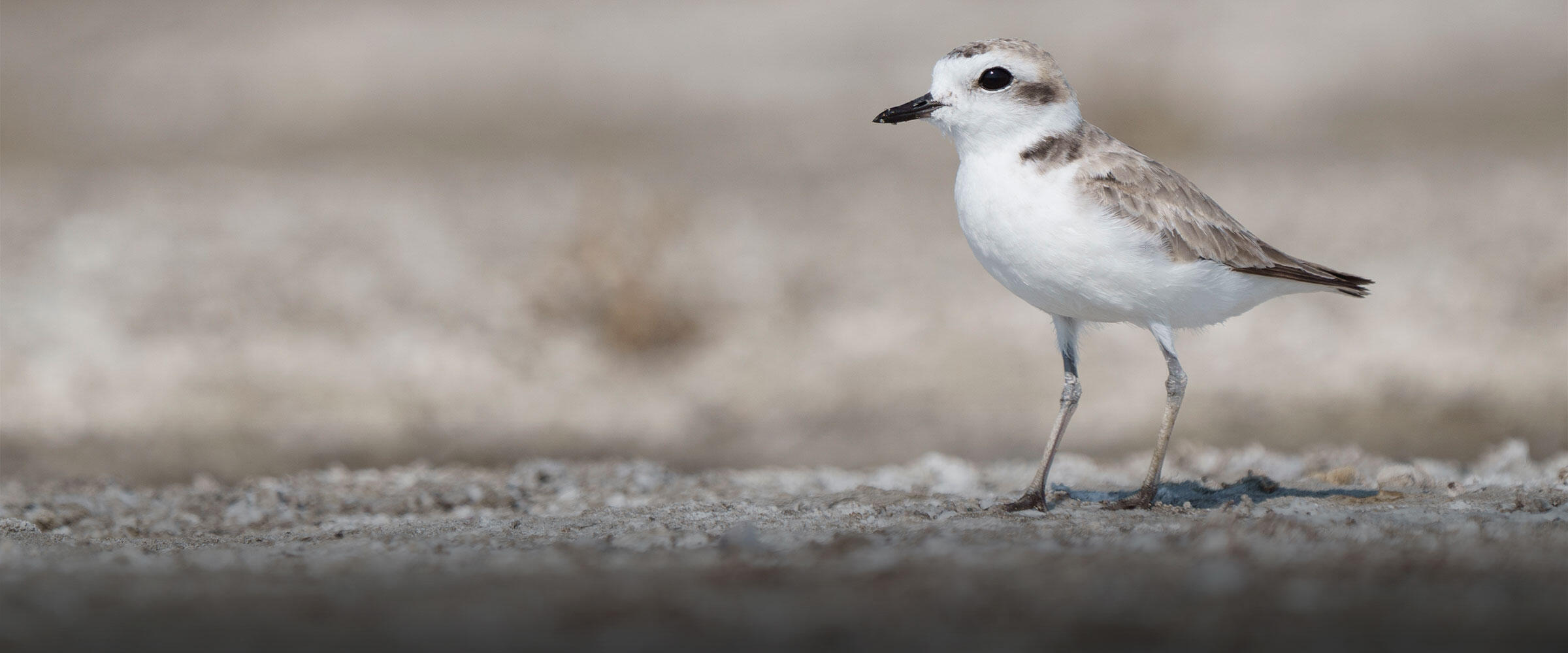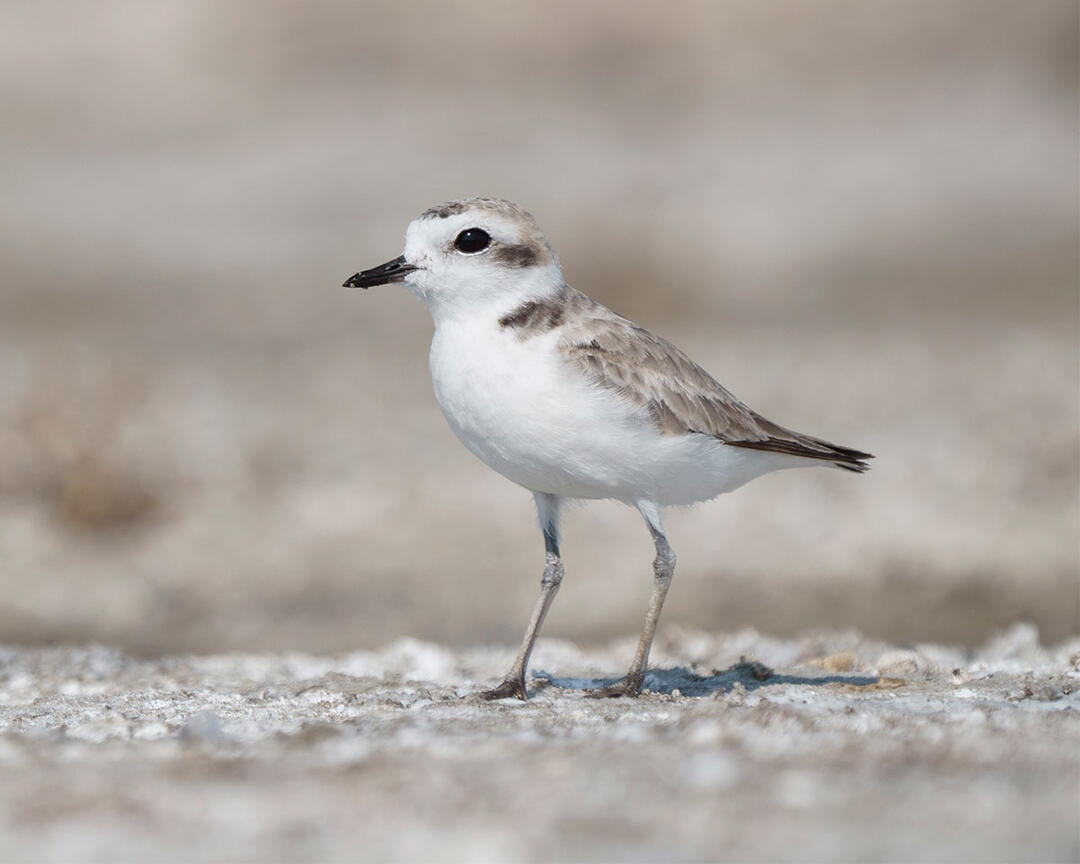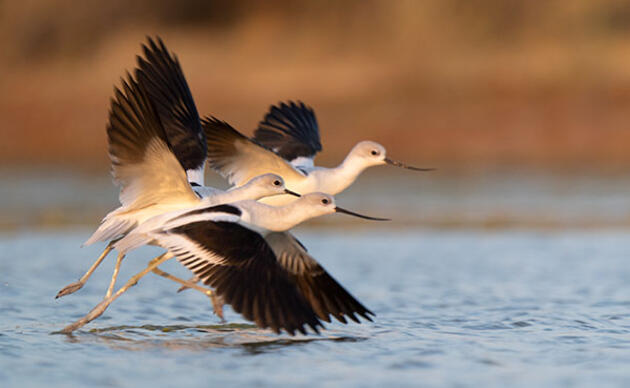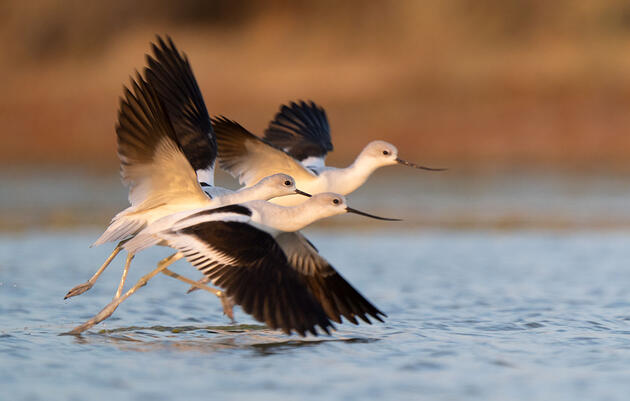Meet Great Salt Lake’s Cutest, Toughest Shorebird
Snowy Plover (Anarhynchus nivosus) are impossibly cute, but don’t let that fool you. Although small in size, they are one of the toughest and most well-adapted shorebirds you’ll find at Audubon’s Gillmor Sanctuary and Great Salt Lake. Their perfectly colored feathers match the tans and greys of moist, silty sand, and their white throat and belly can be mistaken for the salt-crusted shores that spread for miles around the lake during the heat of the summer.
One of the earliest bird species to arrive at Great Salt Lake during spring migration, Snowy Plover quickly forage on brine fly pupae and brine shrimp at the lake’s edge, while waiting for brine fly adults to emerge. Or, they search for insects lining the edges of stranded salty pools of water that fill small depressions out in the sand. As Great Salt Lake has relinquished vast expanses of salty mudflats during years of declining water levels and warming temperatures, one might think that there’s no shortage of Snowy Plover habitat. But that’s simply not the case. Snowy Plovers thrive on the life that water supports. Without water nearby, there is no food.
The Challenges at Great Salt Lake

After arriving at Great Salt Lake from their wintering grounds in late March and early April, building up energy and reserves and enduring cold spring storms is only the beginning of the Snowy Plovers’ challenges. Many predators that patrol the lake from the sky and ground. Peregrine and Prairie Falcons, gulls, and ravens are among their feathered foes, while coyotes, raccoons, and skunks also keep watch for a hint of plover movement. As humans lay their network of roads and paths closer to the lake, predators find it easier to make their way to plover habitat.
By May, breeding season begins in earnest and the shores of the lake are teaming with life. Many shorebird species come to Great Salt Lake to breed, but Snowy Plover are the only ones that stake out nesting territory out on the flats. You might think it’s foolish to lay eggs so completely exposed to the world around them, but the birds and eggs are uniquely adapted to survive there. The eggs (usually a clutch of three) are remarkably speckled and spattered with a palette of colors that mimic those of sand, rocks, salt, and fragments of wood. Another favorite nesting location is in areas of sparse, salt-tolerant pickleweed (Salicornia rubra). The plant provides dried stems from the previous year’s growth to line the small nest cup (3.5 inches / 7.0 cm wide) where the plover eggs lay.

The well-camouflaged adults take turns throughout day and night, incubating the eggs for approximately 27 days. Preventing the eggs from overheating and dehydrating is an increasingly difficult challenge for the adults, with daytime temperatures nearing and exceeding 100 degrees Fahrenheit for weeks at a time. It’s hot for the adults also, and they spend plenty of energy running for shade and then returning to give their partner a break.
If the eggs hatch successfully, the chicks stay close by for the first hours of their life to dry their downy cover before being led away from the nest by the adult. Predators can pick up the scent of a freshly hatched egg, so it is dangerous to remain at the nest site for long. Additionally, the adults need to lead the hatchlings to a safe feeding area. While all this takes place, people are using the beach areas as well. It isn’t currently clear what degree of human recreational use of Great Salt Lake’s beaches is compatible with successful Snowy Plover nesting.
There are many urgent reasons to assess the current population of Snowy Plovers that nest in the western interior of North America. It is believed that this population has declined since it was last surveyed. Since the south shore of Great Salt Lake was identified previously by scientists as an important nesting ground, recreational use has increased in the nesting areas, including motorized recreation. It has been shown that ground-nesting birds on beaches are at serious risk to nest loss when, for example, people walk their dogs off leash.
The Snowy Plover Monitoring Program

To better understand these challenges and their impacts, Audubon’s Gillmor Sanctuary and Saline Lakes Programs partnered with Tracy Aviary's Conservation Team to build the Snowy Plover Monitoring Program. The program aims to determine how different types of human recreation affect Snowy Plovers in high-density nesting areas. It also compares the effects of recreation with wildlife predation of eggs and chicks when it comes to nest success and fledged young. As we continue monitoring and analyzing the data, we will share what we learn with the local Salt Lake community, other scientists, as well as provide guidance toward helping to conseve this charismatic little bird.
Finding answers to these and other important questions will help us learn how we can help bend the curve to positive numbers of Snowy Plover at Great Salt Lake. Now, we’re expanding the program, and you can help!
There are many ways to get involved, even if you don’t have experience birding! All you need is passion and some time to give. If you are interested in volunteering for the Snowy Plover Monitoring Project, please sign up for volunteer training here. Surveys occur from late April through early August and transportation support to survey sites available as needed.
We can't wait for you to join our team!
Written by Heidi Hoven, Ph.D., senior manager of Audubon's Gillmor Sanctuary at Great Salt Lake.
Related
Audubon's Edward L. & Charles F. Gillmor Sanctuary
Protecting critically important shorebird habitat along Great Salt Lake.
Monitoring Snowy Plovers at Great Salt Lake
An Updated Look at One of Utah’s Shorebird Species of Greatest Conservation Need
Get Involved at Gillmor Sanctuary
Discover events, volunteer programs, and other opportunities to help birds at Gillmor Sanctuary and Great Salt Lake.









